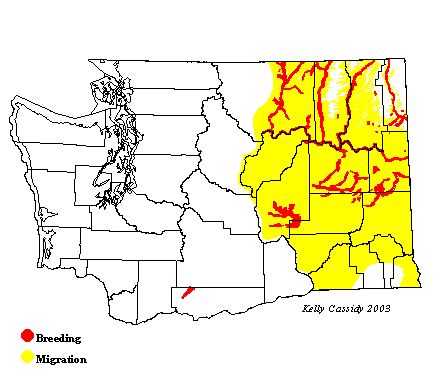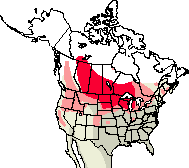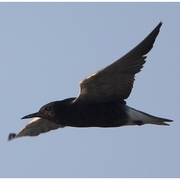Black Tern
The Washington representatives of this family can be split into two groups, or subfamilies. The adaptable gulls are the most familiar. Sociable in all seasons, they are mainly coastal, but a number of species also nest inland. Many—but not all—are found around people. Gulls have highly variable foraging techniques and diets. Terns forage in flight, swooping to catch fish or insects. They dive headfirst into the water for fish. Although they are likely to be near water, they spend less time swimming than gulls.
General Description
A small, graceful, black and silver bird, the Black Tern has relatively broad wings and a short tail that is only slightly forked. In breeding plumage, it has a black body and head, silvery gray wings and a white vent. The legs and bill are also black. In non-breeding plumage, the Black Tern has a white belly and breast. The black on its head recedes, leaving dark sideburns, and is replaced with a white face. The legs are orange. Juveniles appear similar to adults in non-breeding plumage, but the gray mantle is mottled.
Habitat
A marsh-breeding bird, the Black Tern nests in freshwater wetlands in Eastern Washington, mostly east of the Okanogan and Columbia Rivers. For nesting, it requires habitat with extensive, cover-providing, vegetation as well as open water. During migration, it uses large lakes and coastlines. In winter, it can be found along productive marine coastlines, lagoons and estuaries, especially off the Pacific Coast of Panama.
Behavior
Black Terns swoop to pluck food from the water's surface; they rarely plunge-dive under the water. They will also forage in flight, snatching flying insects out of the air. Highly social, they often forage in flocks.
Diet
In the breeding season, insects are the primary food source, although small fish and other aquatic creatures are also eaten. During migration and in winter, small fish make up the bulk of the diet.
Nesting
Breeding in scattered colonies, often associated with Forster's Terns, Black Terns nest low in marshes, on floating vegetation mats, muskrat houses, or on the ground near water. Both parents help build a nest which ranges from a substantial mound of vegetation to a simple depression with a little bit of vegetation added. When mixed with Forster's Terns, the Black Tern nests tend to be lower, closer to the water. In fact, the eggs of Black Terns are adapted to get wet (but not for extended periods of time), and are often moist. Both parents incubate the 2-4 eggs for about three weeks. After 2-3 days they may leave the nest, but stay close by. In approximately three weeks the young are ready to fly, but they may be fed by their parents for up to 2 more weeks. Typically only one brood is raised each year.
Migration Status
In the fall, Black Terns gather at feeding sites that are often north of breeding colonies, and then migrate south in groups. Spring migration is more direct, and migration, during both seasons, is usually over land. It appears that Black Terns nesting in the west may move south to the coast of Mexico, and then continue further south offshore.
Conservation Status
Numbers have decreased since the 1960s due, in part to the destruction or degradation of much of their breeding and migration stopover habitat. Other potential impacts on the population are increased fertilizer runoff causing chemical contamination in wetlands, and overfishing in winter habitat. It is federally designated as a category 2 candidate for listing under the endangered species act, and is included on the Washington Gap Analysis list of birds at-risk.
When and Where to Find in Washington
Common in parts of eastern Washington from May to mid-August, and rare in westerrn Washington from July to early September. Black Terns readily change colony sites, so there are not well established colonies that are a sure bet to find them at. They occur mostly east of the Okanogan and Columbia Rivers and in some years they also nest in Klickitat County and at Conboy Lake National Wildlife Refuge. They are most common in the northeast part of the state, and hundreds often nest at the Turnbull National Wildlife Refuge in Spokane County. During migration, Black Terns can be observed in wetlands throughout eastern Washington.
 Abundance
Abundance
| Ecoregion | Jan | Feb | Mar | Apr | May | Jun | Jul | Aug | Sep | Oct | Nov | Dec |
|---|---|---|---|---|---|---|---|---|---|---|---|---|
| Oceanic | ||||||||||||
| Pacific Northwest Coast | ||||||||||||
| Puget Trough | R | R | R | R | ||||||||
| North Cascades | ||||||||||||
| West Cascades | ||||||||||||
| East Cascades | R | R | ||||||||||
| Okanogan | U | F | F | U | ||||||||
| Canadian Rockies | U | F | U | R | ||||||||
| Blue Mountains | ||||||||||||
| Columbia Plateau | U | U | U | U |
Washington Range Map

North American Range Map


Family Members
 Laughing GullLarus atricilla
Laughing GullLarus atricilla Franklin's GullLarus pipixcan
Franklin's GullLarus pipixcan Little GullLarus minutus
Little GullLarus minutus Black-headed GullLarus ridibundus
Black-headed GullLarus ridibundus Bonaparte's GullLarus philadelphia
Bonaparte's GullLarus philadelphia Heermann's GullLarus heermanni
Heermann's GullLarus heermanni Black-tailed GullLarus crassirostris
Black-tailed GullLarus crassirostris Short-billed GullLarus canus
Short-billed GullLarus canus Ring-billed GullLarus delawarensis
Ring-billed GullLarus delawarensis California GullLarus californicus
California GullLarus californicus Herring GullLarus argentatus
Herring GullLarus argentatus Thayer's GullLarus thayeri
Thayer's GullLarus thayeri Iceland GullLarus glaucoides
Iceland GullLarus glaucoides Lesser Black-backed GullLarus fuscus
Lesser Black-backed GullLarus fuscus Slaty-backed GullLarus schistisagus
Slaty-backed GullLarus schistisagus Western GullLarus occidentalis
Western GullLarus occidentalis Glaucous-winged GullLarus glaucescens
Glaucous-winged GullLarus glaucescens Glaucous GullLarus hyperboreus
Glaucous GullLarus hyperboreus Great Black-backed GullLarus marinus
Great Black-backed GullLarus marinus Sabine's GullXema sabini
Sabine's GullXema sabini Black-legged KittiwakeRissa tridactyla
Black-legged KittiwakeRissa tridactyla Red-legged KittiwakeRissa brevirostris
Red-legged KittiwakeRissa brevirostris Ross's GullRhodostethia rosea
Ross's GullRhodostethia rosea Ivory GullPagophila eburnea
Ivory GullPagophila eburnea Least TernSternula antillarum
Least TernSternula antillarum Caspian TernHydroprogne caspia
Caspian TernHydroprogne caspia Black TernChlidonias niger
Black TernChlidonias niger Common TernSterna hirundo
Common TernSterna hirundo Arctic TernSterna paradisaea
Arctic TernSterna paradisaea Forster's TernSterna forsteri
Forster's TernSterna forsteri Elegant TernThalasseus elegans
Elegant TernThalasseus elegans

